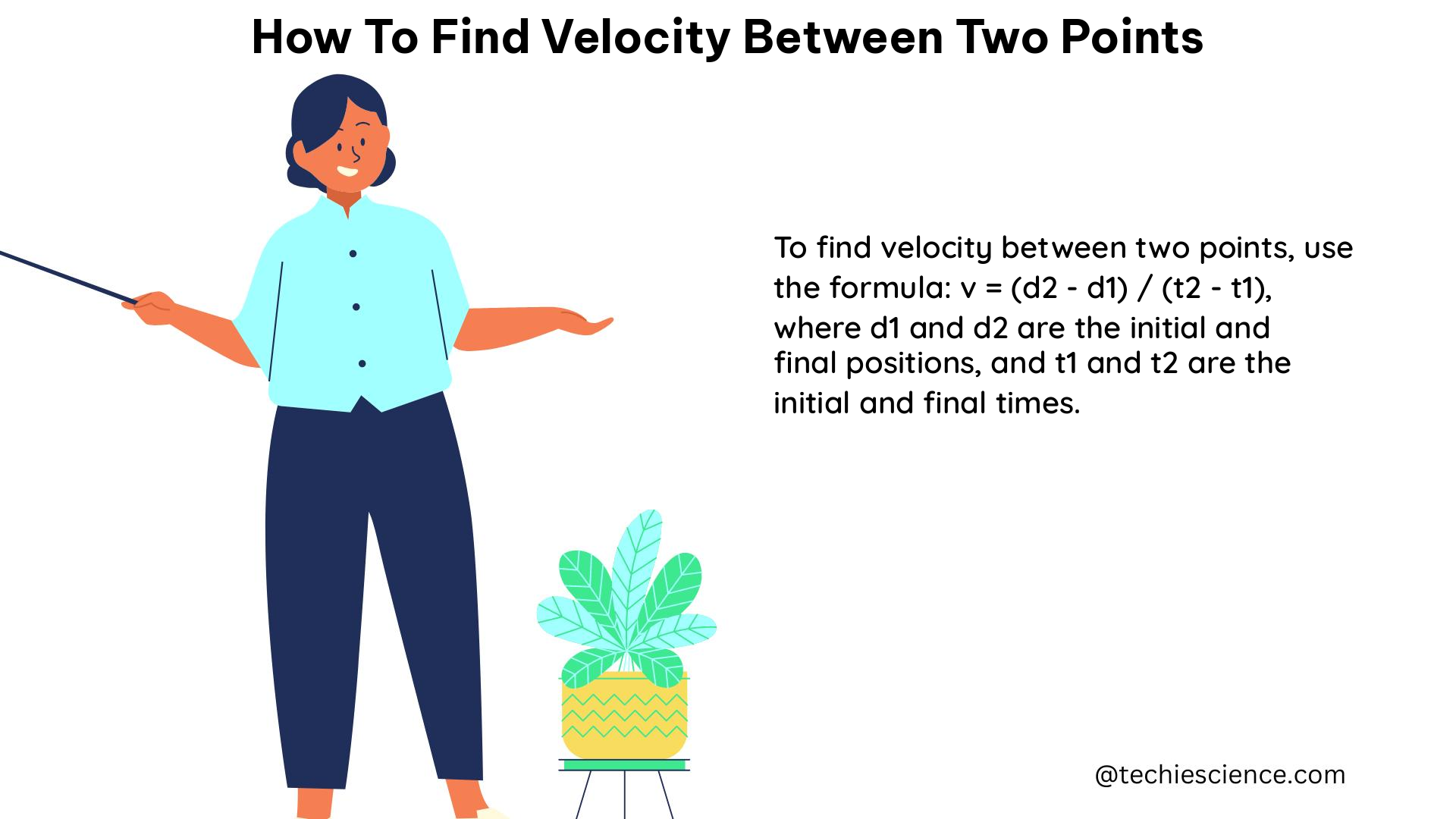Summary
Calculating the velocity between two points is a fundamental concept in physics and is essential for understanding the motion of objects. This comprehensive guide will provide you with a step-by-step approach to finding the velocity between two points, including the necessary formulas, examples, and data points to help you master this skill.
Understanding Velocity

Velocity is a vector quantity that describes the rate of change of an object’s position with respect to time. It is defined as the displacement of an object divided by the time it takes to cover that displacement. The formula for velocity is:
v = Δd / Δt
where:
– v is the velocity
– Δd is the change in displacement
– Δt is the change in time
Calculating Displacement
To find the velocity between two points, you first need to calculate the change in displacement, Δd. This can be done using the distance formula:
Δd = √[(x₂ - x₁)² + (y₂ - y₁)²]
where:
– (x₁, y₁) are the coordinates of the first point
– (x₂, y₂) are the coordinates of the second point
The displacement Δd represents the straight-line distance between the two points, regardless of the path taken.
Example
Let’s say we have the following two points:
– Point 1: (1, 2) at time t = 0 seconds
– Point 2: (4, 5) at time t = 2 seconds
To calculate the change in displacement, we can use the distance formula:
Δd = √[(4 - 1)² + (5 - 2)²]
= √[3² + 3²]
= √[9 + 9]
= √18
= 4.24 meters
Calculating Time
The change in time, Δt, is simply the difference between the time of the second point and the time of the first point:
Δt = t₂ - t₁
In the example above, the change in time is:
Δt = 2 seconds - 0 seconds = 2 seconds
Calculating Velocity
Now that we have the change in displacement, Δd, and the change in time, Δt, we can plug these values into the velocity formula to find the velocity:
v = Δd / Δt
= 4.24 meters / 2 seconds
= 2.12 meters per second (m/s)
Therefore, the velocity of the object between the two points is 2.12 m/s.
Additional Considerations
- Units: The units for displacement can be meters, feet, miles, etc., and the units for time can be seconds, minutes, hours, days, etc. The resulting velocity will have units of meters per second (m/s), feet per second (ft/s), miles per hour (mph), etc., depending on the units used for displacement and time.
- Straight-line Motion: The formula for velocity assumes that the object is moving in a straight line between the two points. If the object’s path is not a straight line, you may need to use more advanced techniques to calculate the velocity.
- Instantaneous Velocity: The velocity calculated using the formula above is the average velocity between the two points. To find the instantaneous velocity at a specific point, you would need to take the limit of the average velocity as the time interval approaches zero.
Practical Applications
Calculating the velocity between two points has many practical applications, including:
- Kinematics: In the study of kinematics, the branch of physics that deals with the motion of objects, finding the velocity between two points is a fundamental skill.
- Transportation: Calculating the velocity of vehicles, such as cars, trains, or airplanes, is essential for transportation planning, traffic management, and safety.
- Sports and Athletics: Measuring the velocity of moving objects, such as balls, athletes, or projectiles, is crucial for understanding and improving sports performance.
- Robotics and Automation: Accurately determining the velocity of moving parts is essential for the precise control and coordination of robotic systems.
- Astronomy and Astrophysics: Calculating the velocity of celestial bodies, such as planets, stars, or galaxies, is crucial for understanding their motion and the dynamics of the universe.
Conclusion
Mastering the skill of finding the velocity between two points is essential for any student or professional working in the field of physics or related disciplines. By understanding the underlying concepts, formulas, and practical applications, you can become proficient in this fundamental skill and apply it to a wide range of real-world problems.
References
- How to estimate the velocity from the displacement of points
- How to calculate velocity in scrum
- Average Velocity: Between Two Points – YouTube
- 4 Ways to Calculate Velocity – wikiHow
- Average Velocity | Definition, Formula & Calculation – Lesson

The lambdageeks.com Core SME Team is a group of experienced subject matter experts from diverse scientific and technical fields including Physics, Chemistry, Technology,Electronics & Electrical Engineering, Automotive, Mechanical Engineering. Our team collaborates to create high-quality, well-researched articles on a wide range of science and technology topics for the lambdageeks.com website.
All Our Senior SME are having more than 7 Years of experience in the respective fields . They are either Working Industry Professionals or assocaited With different Universities. Refer Our Authors Page to get to know About our Core SMEs.